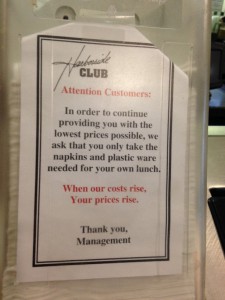I’ve been following the Watch reaction since its unveiling last week, and I keep coming back to the short-sightedness of the luxury watchmakers’ reaction.
Mostly, the watch industry has been complimentary, in its way, of the Apple Watch. They are right to compartmentalize it as fundamentally different from their products, and to appreciate it on its own level. Sample quote: “I do not believe it poses any threat to haute horology manufactures, I do think the Apple Watch will be a big problem for low-priced quartz watches, and even some entry-level mechanical watches.” (Monday Note has a good roundup.)
But here’s the thing: anyone who buys an Apple Watch is going to stop buying other watches, regardless of price point.
I keep thinking about my own use case. I’ve been a daily watch wearer since elementary school. I wear a watch with a great degree of pride, as the accessory I rely on. My watches are carefully chosen, and whether an inexpensive Swatch, an oversized Nixon or a finely crafted Breitling, they are a fixture in my life.
Of course, I’m also a daily Apple user, and an early adopter of their products. I own the first-generation iPod, the first iPhone, the first iPad. I undoubtedly will buy the Watch, even though I’m not a rabid message-sender, even though I’m not a jogger, even though I’m not yet 100% certain where the new device journey will lead me. It’s a new Apple gadget and it’s a watch—I’m powerless to resist.
And once I have the Watch, I’m going to wear it regularly. I will tinker with it, find its ideal use cases, answer a thousand questions about it, be proud of it as I was my other first-gen Apple products and every one of my watches. As with the iPhone, I expect it to become part of my daily routine.
And once I’m doing that, well, my other watches don’t stand a chance. Because as the Watch assimilates itself to my life’s rhythms (or, perhaps, vice versa), not wearing the Apple Watch will feel like something’s missing. The vibrations and alerts and shortcuts that aren’t offered by my quartz Zodiac will be glaring omissions. Before long, I’ll be strapping on the Watch every day, just as I put my iPhone in my pocket.
If the Watch works for me, my workaday watches will slowly get relegated to my nightstand drawer, and future watch purchases will shift from investing in the next object of beauty and personal expression to saving a few bucks for Watch 2. And Apple will then own a thirty-year habit of mine, just like they came to own my music and phone habits, too.
Frankly, I’m not even sure I’m happy about this. But I’m going for it. I expect millions of folks like me will, too, and when they do, the disruption to the watch industry will not be pretty.
